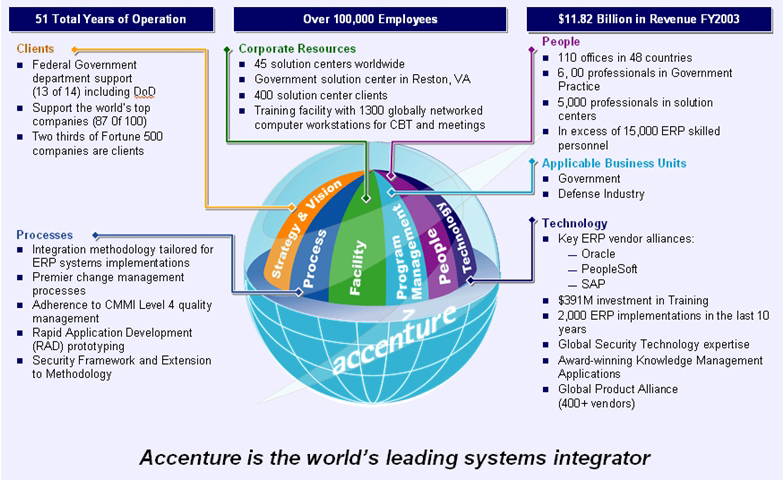IT implementation is “bread and butter work”
It often involves dozens of consultants, multiple locations, and sometimes 2-3 years for a full roll out of an enterprise resource plan (ERP) like SAP or Oracle. These are big hairy projects that cost dozens, if not hundreds, of millions of dollars. It’s big money.
It is complicated work
It not only feeds the IT service arms of consulting firms, there is often strategy, human capital, program management, and other types of work. If you want a sense of how complex it can be, just look at this onion-looking graphic from Accenture’s website bragging about their capabilities. Click photo for source.
It is big consulting fees
Look at this list of Accenture ERP projects from the same website. HP, IRS, Mobil, Dupont, Marriott, NASA, ABB, South African Breweries, Asahi, Philip Morris, and US Department of State. Click photo for case studies.
www.healthcare.gov is a big deal
The big IT implementation news recently was the failed launch of the US government website: www.healthcare.gov. This site was intended to serve as a marketplace for buyers and sellers of healthcare insurance. It was meant to bring 34 million+ uninsured Americans closer to healthcare access. Did not happen. Instead, this is what most people saw. In fact, this is a screenshot from today (11/3/13).
This is a fail
I am not an IT implementation expert. In fact, the most tech-savvy thing I do is probably blog on this site. That said, launching a website this poorly is a fail. Yes, the scope of the website was vast (linking to 36 state healthcare exchanges), but that is why it had to succeed. The stakes were high, and it was an embarrassment.
Why did it fail?
I dug up an article from CIO magazine entitled 13 Common ERP mistakes and how to avoid them. Even though this was not an ERP implementation, the website launch made most of these mistakes. Ouch.
- Poor planning
- Not properly vetting vendors
- Not understanding or using key features
- Underestimating the time and resources required
- Not having the right people on the team from the start
- Not setting priorities
- Not investing in training and change management
- Underestimating the importance of accurate data
- Taking the kitchen sink approach
- Not decommissioning legacy applications
- Not having an active load environment
- Ignoring third party support alternatives
- Not having a maintenance strategy
#2 Not property vetting vendors
Don’t know much about the 3 vendors the US government chose – but on some level – they were the wrong ones. Did not do the job, and failed to warn their client (US government) with enough conviction to prevent the public relationship train wreck. Much of the last two weeks has been spent calling people to testify before Congress and blame each other.
#4 Underestimating the time and resources required
Here is a quote from the vendor 1 month prior to launch “Due to the compressed schedule, there is not enough time built in to allow for adequate performance testing,”
#6 Not setting priorities
“One expert counted 92 separate files and plugins—including 56 JavaScript files—that users had to download when they hit the “apply” button on HealthCare.gov. Another said that the amount of data passed back and forth was so intense, it made it appear “as if the system was attacking itself.” Click here for the article.
#7 Not investing in training and change management
This one is almost too ugly to mention. Apparently, in the middle of this mess – when people could not log-on, and were calling customer service, the reps were using the wrong script. They were telling users to reset their passwords, which may have made matter worse.
#8 Underestimating the importance of accurate data
Some of the insurance companies complained that they were receiving incomplete and duplicate applications.
There were other issues too, but its too depressing to recount. I am a big believer in affordable healthcare for all Americans. People can agree or disagree about the Affordable Care Act (nicknamed “Obamacare”), but everyone will agree this was an awful way to start.
Related: McKinsey “red team” report foreshadowed potential problems with site.

